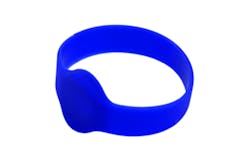CORVALLIS, Ore. — Scientists at Oregon State University have created a silicone bracelet with a porous surface that mimics a cell, acting as a pollution detector, according to an article by Hood River News.
The wristband's surface absorbs chemicals that people are exposed to, the release reported.
“The wristbands show us the broad range of chemicals we encounter but often don’t know about and may be harming us,” said Kim Anderson, a professor in OSU’s College of Agricultural Sciences. “Eventually, these bracelets may help us link possible health effects to chemicals in our environment.”
Thirty volunteers, including roofers, wore the bracelets for a month, continued the release, and the wristbands were able to detect nearly 50 chemical compounds, including fragrances, personal care products, flame-retardants, pesticides, caffeine, nicotine, chemicals from pet flea medicines and polycyclic aromatic hydrocarbons.
The bracelets, which are not yet available to the public, cannot detect some metals like lead and chromium or gases like carbon monoxide, noted the release.
Read the full article here.


